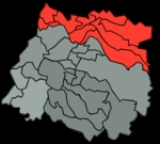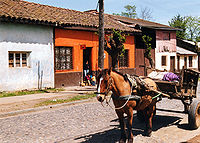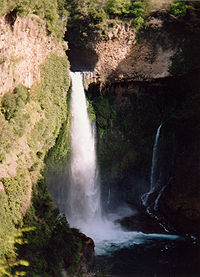
Curicó Province
Encyclopedia
Curicó Province is one of four provinces
of the central Chile
an region of Maule
(VII). Its capital is the city of Curicó
. It lies between the provinces of Colchagua
and Talca
and extends from the Pacific to the Argentine
frontier, spanning an area of 7280.9 sqkm. According to the 2002 census, the population was 244,053.
of Chile, governed by a provincial governor
who is appointed by the president
.
and municipal council
.
 The region is named for the Curis one of the tribes of Picunche
The region is named for the Curis one of the tribes of Picunche
or Promaucaes
settled along the rivers of the central valley flowing into the Mataquito River, around the modern city of Curicó
. Others tribes were the Tenu along the Teno River
(the modern Rauco
and Teno
communes) to the north. To the south were the Gualemo along the Lontué River
the modern Molina
commune. Along the Mataquito were the tribes centered on the modern towns of Palquibudi in Sagrada Familia commune, La Huerta
in Hualañé
commune and Lora
in Licantén
commune. On the coast north of the river, the Vichuquén
in the commune of the same name .
The province was created in 1865. Formerly it was part of the Colchagua Province. In 1974, because of a regionalisation process in Chile during the Augusto Pinochet regime executed by CONARA (Comisión Nacional de Reforma Administrativa in Spanish, National Commission of Administrative Reform in English), the province was reshaped, taking place in the recently created Maule Region.
 The eastern and western sections of Curicó Province are mountainous, and are separated by the fertile valley of central Chile. The provincial capital is Curicó
The eastern and western sections of Curicó Province are mountainous, and are separated by the fertile valley of central Chile. The provincial capital is Curicó
, on the Mataquito River
, 194 km south of Santiago
. In some of the mountainous areas of the province is found the endangered Chilean Wine Palm, Jubaea chilensis, whose southern range is generally defined by the northern Maule Region
, e.g. Curicó Province; historically, this endemic Chilean palm had a much wider distribution.
(INE), the province spans an area of 7280.9 sqkm and had a population of 244,053 inhabitants (122,835 men and 121,218 women), giving it a population density of 33.5 PD/sqkm. Between the 1992 and 2002 censuses, the population grew by 10.6% (23,396 persons).
Provinces of Chile
A province is the second largest administrative division in Chile, after a region. Each region is divided into provinces. There are 54 provinces in total....
of the central Chile
Chile
Chile ,officially the Republic of Chile , is a country in South America occupying a long, narrow coastal strip between the Andes mountains to the east and the Pacific Ocean to the west. It borders Peru to the north, Bolivia to the northeast, Argentina to the east, and the Drake Passage in the far...
an region of Maule
Maule Region
The VII Maule Region is one of Chile's 15 first order administrative divisions. Its capital is Talca. The region takes its name from the Maule River which, running westward from the Andes, bisects the region and spans a basin of about 20,600 km2...
(VII). Its capital is the city of Curicó
Curicó
Curicó , meaning "Black Waters" in Mapudungun , is the capital city of the Curicó Province, part of the Maule Region in Chile's central valley....
. It lies between the provinces of Colchagua
Colchagua Province
Colchagua Province is one of three provinces of the central Chilean region of O'Higgins . Its capital is San Fernando. It is bordered on the north by Cachapoal Province, on the east by the Argentine Republic, on the south by Curicó Province, and on the west by Cardenal Caro Province.-Geography and...
and Talca
Talca Province
Talca Province is one of four provinces of the central Chilean region of Maule . Its capital is the city of Talca.-Administration:As a province, Talca is a second-level administrative division of Chile, governed by a provincial governor who is appointed by the president.-Communes:The province...
and extends from the Pacific to the Argentine
Argentina
Argentina , officially the Argentine Republic , is the second largest country in South America by land area, after Brazil. It is constituted as a federation of 23 provinces and an autonomous city, Buenos Aires...
frontier, spanning an area of 7280.9 sqkm. According to the 2002 census, the population was 244,053.
Administration
As a province, Curicó is a second-level administrative divisionAdministrative divisions of Chile
The administrative division or territorial organization of Chile exemplifies characteristics of a unitary state. State administration is functionally and geographically decentralized, as appropriate for each authority in accordance with the law....
of Chile, governed by a provincial governor
Governor
A governor is a governing official, usually the executive of a non-sovereign level of government, ranking under the head of state...
who is appointed by the president
President of Chile
The President of the Republic of Chile is both the head of state and the head of government of the Republic of Chile. The President is responsible of the government and state administration...
.
Communes
The province is composed of nine communes, each governed by a municipality consisting of an alcaldeAlcalde
Alcalde , or Alcalde ordinario, is the traditional Spanish municipal magistrate, who had both judicial and administrative functions. An alcalde was, in the absence of a corregidor, the presiding officer of the Castilian cabildo and judge of first instance of a town...
and municipal council
Municipal council
A municipal council is the local government of a municipality. Specifically the term can refer to the institutions of various countries that can be translated by this term...
.
- CuricóCuricóCuricó , meaning "Black Waters" in Mapudungun , is the capital city of the Curicó Province, part of the Maule Region in Chile's central valley....
- HualañéHualañéHualañé is a town and commune of the Curicó Province in Chile's eighth region of Maule.Situated in the Mataquito River valley, its main activities are the agriculture of tomatoes, potatoes, and grapes for wine...
- LicanténLicanténLicantén is a town within the Licantén commune, administered by the Municipality of Licantén within the Curicó Province in the Maule Region of Chile. The commune also include the coastal town of Iloca.-Demographics:...
- MolinaMolina, ChileMolina is a Chilean city and commune in Curicó Province, Maule Region.-Demographics:According to the 2002 census of the National Statistics Institute, Molina spans an area of and has 38,521 inhabitants . Of these, 28,232 lived in urban areas and 10,289 in rural areas...
- RaucoRaucoRauco is a Chilean town and commune in Curicó Province, Maule Region. The commune spans an area of .-Demographics:According to the 2002 census by the National Statistics Institute, Rauco commune had 8,566 inhabitants 4,364 men and 4,202 women. Of these, 3,114 lived in urban areas and 5,452 in...
- RomeralRomeralRomeral is a Chilean town and commune in Curicó Province, Maule Region. The commune spans and area of .-Demographics:According to the 2002 census of Population and Housing by the National Statistics Institute, the Romeral commune had 12,707 inhabitants; of these, 3,675 lived in urban areas and...
- Sagrada Familia
- TenoTenoTeno is a Chilean city and commune in the Curicó Province, Maule Region. A large percentage of inhabitants are of mestizo and Mapuche Indian origin...
- VichuquénVichuquénVichuquén is a commune in the Curicó Province of Chile's Maule Region.- History :The Spanish arrived along the Lico rivers in 1585, where settlements of the Mapuche and Inca already existed. In 1865, Vichuquén founded its capital of the village of the same name....
History

Picunche
The Picunche , also referred to as picones by the Spanish, were a mapudungun speaking Chilean people living to the north of the Mapuches or Araucanians and south of the Choapa River and the Diaguitas...
or Promaucaes
Promaucaes
Promaucaes, Promaucas or Purumaucas ; pre-Columbian Mapuche tribal group that lived in the present territory of Chile, south of the Maipo River basin of Santiago, Chile and the Itata River,...
settled along the rivers of the central valley flowing into the Mataquito River, around the modern city of Curicó
Curicó
Curicó , meaning "Black Waters" in Mapudungun , is the capital city of the Curicó Province, part of the Maule Region in Chile's central valley....
. Others tribes were the Tenu along the Teno River
Teno River
The Teno River is a river located in the Maule Region of central Chile. It begins at the confluence of the Malo and Nacimiento rivers. The former originates north of Planchón volcano at Lagunas de Teno. The river flows initially northwest across the Andes...
(the modern Rauco
Rauco
Rauco is a Chilean town and commune in Curicó Province, Maule Region. The commune spans an area of .-Demographics:According to the 2002 census by the National Statistics Institute, Rauco commune had 8,566 inhabitants 4,364 men and 4,202 women. Of these, 3,114 lived in urban areas and 5,452 in...
and Teno
Teno
Teno is a Chilean city and commune in the Curicó Province, Maule Region. A large percentage of inhabitants are of mestizo and Mapuche Indian origin...
communes) to the north. To the south were the Gualemo along the Lontué River
Lontué River
The Lontué River is a river in the province of Curicó in Chile. It originates about 50 km east of Curicó, at the confluence of the Colorado River and the Los Patos River. Both rivers have their origin next to the volcanos Descabezado Chico and Descabezado Grande...
the modern Molina
Molina, Chile
Molina is a Chilean city and commune in Curicó Province, Maule Region.-Demographics:According to the 2002 census of the National Statistics Institute, Molina spans an area of and has 38,521 inhabitants . Of these, 28,232 lived in urban areas and 10,289 in rural areas...
commune. Along the Mataquito were the tribes centered on the modern towns of Palquibudi in Sagrada Familia commune, La Huerta
La Huerta
La Huerta, or Huerta de Mataquito is a village or small town near the north bank of the Mataquito River, in the Hualañé commune, in the Curicó Province, in the Maule Region, of Chile...
in Hualañé
Hualañé
Hualañé is a town and commune of the Curicó Province in Chile's eighth region of Maule.Situated in the Mataquito River valley, its main activities are the agriculture of tomatoes, potatoes, and grapes for wine...
commune and Lora
Lora, Chile
Lora is a town on the Mataquito River, in the Licantén commune of the Curicó Province, Maule Region, in Chile. It was named for the tribe of Promaucaes that inhabited the region.- Sources :* Originally published in 1891....
in Licantén
Licantén
Licantén is a town within the Licantén commune, administered by the Municipality of Licantén within the Curicó Province in the Maule Region of Chile. The commune also include the coastal town of Iloca.-Demographics:...
commune. On the coast north of the river, the Vichuquén
Vichuquén
Vichuquén is a commune in the Curicó Province of Chile's Maule Region.- History :The Spanish arrived along the Lico rivers in 1585, where settlements of the Mapuche and Inca already existed. In 1865, Vichuquén founded its capital of the village of the same name....
in the commune of the same name .
The province was created in 1865. Formerly it was part of the Colchagua Province. In 1974, because of a regionalisation process in Chile during the Augusto Pinochet regime executed by CONARA (Comisión Nacional de Reforma Administrativa in Spanish, National Commission of Administrative Reform in English), the province was reshaped, taking place in the recently created Maule Region.
Geography and ecology

Curicó
Curicó , meaning "Black Waters" in Mapudungun , is the capital city of the Curicó Province, part of the Maule Region in Chile's central valley....
, on the Mataquito River
Mataquito River
Mataquito is a river located in the Province of Curicó, Maule Region of Chile and formed by the union of rivers Teno and Lontué about 10 kilometers west of Curicó near the locality of Sagrada Familia and empties into the Pacific Ocean south of the town of Iloca, Licantén.- Source :*...
, 194 km south of Santiago
Santiago, Chile
Santiago , also known as Santiago de Chile, is the capital and largest city of Chile, and the center of its largest conurbation . It is located in the country's central valley, at an elevation of above mean sea level...
. In some of the mountainous areas of the province is found the endangered Chilean Wine Palm, Jubaea chilensis, whose southern range is generally defined by the northern Maule Region
Maule Region
The VII Maule Region is one of Chile's 15 first order administrative divisions. Its capital is Talca. The region takes its name from the Maule River which, running westward from the Andes, bisects the region and spans a basin of about 20,600 km2...
, e.g. Curicó Province; historically, this endemic Chilean palm had a much wider distribution.
Demography
According to the 2002 census by the National Statistics InstituteNational Statistics Institute (Chile)
The National Statistics Institute of Chile is a state-run organization of the Government of Chile, created in the second half of the 19th century and tasked with performing a general census of population and housing, then collecting, producing and publishing official demographic statistics of...
(INE), the province spans an area of 7280.9 sqkm and had a population of 244,053 inhabitants (122,835 men and 121,218 women), giving it a population density of 33.5 PD/sqkm. Between the 1992 and 2002 censuses, the population grew by 10.6% (23,396 persons).
Sources
- Thomas Guevara, Historia de Curicó, Alicante : Biblioteca Virtual Miguel de Cervantes, 2000 Originally published in 1891.
- C. Michael Hogan (2008) Chilean Wine Palm: Jubaea chilensis, GlobalTwitcher.com, ed. Nicklas Stromberg

